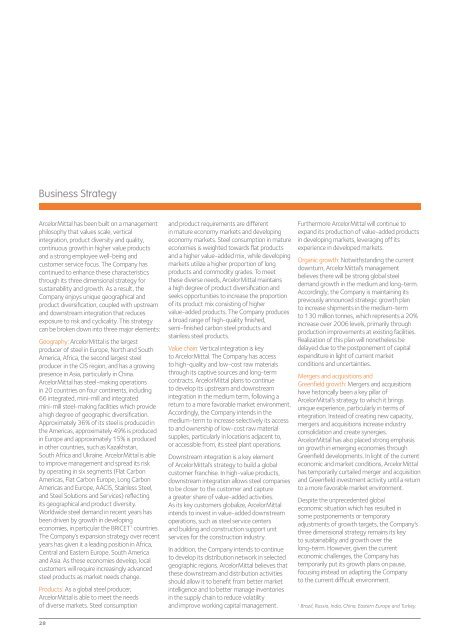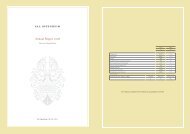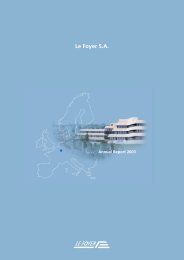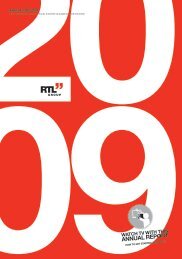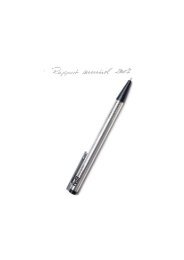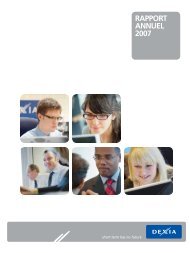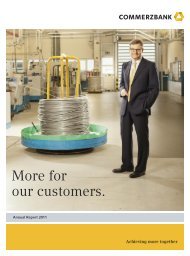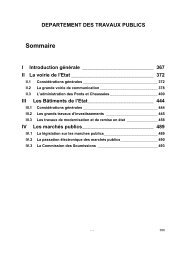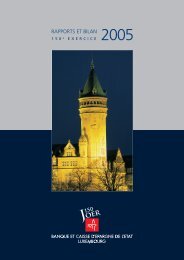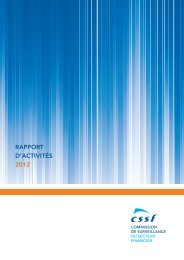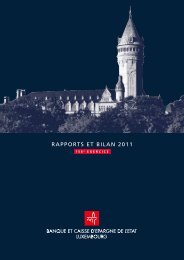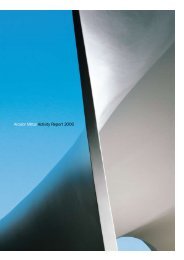ArcelorMittal Annual Report 2008
ArcelorMittal Annual Report 2008
ArcelorMittal Annual Report 2008
You also want an ePaper? Increase the reach of your titles
YUMPU automatically turns print PDFs into web optimized ePapers that Google loves.
Business Strategy<strong>ArcelorMittal</strong> has been built on a managementphilosophy that values scale, verticalintegration, product diversity and quality,continuous growth in higher value productsand a strong employee well-being andcustomer service focus. The Company hascontinued to enhance these characteristicsthrough its three dimensional strategy forsustainability and growth. As a result, theCompany enjoys unique geographical andproduct diversification, coupled with upstreamand downstream integration that reducesexposure to risk and cyclicality. This strategycan be broken down into three major elements:Geography: <strong>ArcelorMittal</strong> is the largestproducer of steel in Europe, North and SouthAmerica, Africa, the second largest steelproducer in the CIS region, and has a growingpresence in Asia, particularly in China.<strong>ArcelorMittal</strong> has steel-making operationsin 20 countries on four continents, including66 integrated, mini-mill and integratedmini-mill steel-making facilities which providea high degree of geographic diversification.Approximately 36% of its steel is produced inthe Americas, approximately 49% is producedin Europe and approximately 15% is producedin other countries, such as Kazakhstan,South Africa and Ukraine. <strong>ArcelorMittal</strong> is ableto improve management and spread its riskby operating in six segments (Flat CarbonAmericas, Flat Carbon Europe, Long CarbonAmericas and Europe, AACIS, Stainless Steel,and Steel Solutions and Services) reflectingits geographical and product diversity.Worldwide steel demand in recent years hasbeen driven by growth in developingeconomies, in particular the BRICET 1 countries.The Company’s expansion strategy over recentyears has given it a leading position in Africa,Central and Eastern Europe, South Americaand Asia. As these economies develop, localcustomers will require increasingly advancedsteel products as market needs change.Products: As a global steel producer,<strong>ArcelorMittal</strong> is able to meet the needsof diverse markets. Steel consumptionand product requirements are differentin mature economy markets and developingeconomy markets. Steel consumption in matureeconomies is weighted towards flat productsand a higher value-added mix, while developingmarkets utilize a higher proportion of longproducts and commodity grades. To meetthese diverse needs, <strong>ArcelorMittal</strong> maintainsa high degree of product diversification andseeks opportunities to increase the proportionof its product mix consisting of highervalue-added products. The Company producesa broad range of high-quality finished,semi-finished carbon steel products andstainless steel products.Value chain: Vertical integration is keyto <strong>ArcelorMittal</strong>. The Company has accessto high-quality and low-cost raw materialsthrough its captive sources and long-termcontracts. <strong>ArcelorMittal</strong> plans to continueto develop its upstream and downstreamintegration in the medium term, following areturn to a more favorable market environment.Accordingly, the Company intends in themedium-term to increase selectively its accessto and ownership of low-cost raw materialsupplies, particularly in locations adjacent to,or accessible from, its steel plant operations.Downstream integration is a key elementof <strong>ArcelorMittal</strong>’s strategy to build a globalcustomer franchise. In high-value products,downstream integration allows steel companiesto be closer to the customer and capturea greater share of value-added activities.As its key customers globalize, <strong>ArcelorMittal</strong>intends to invest in value-added downstreamoperations, such as steel service centersand building and construction support unitservices for the construction industry.In addition, the Company intends to continueto develop its distribution network in selectedgeographic regions. <strong>ArcelorMittal</strong> believes thatthese downstream and distribution activitiesshould allow it to benefit from better marketintelligence and to better manage inventoriesin the supply chain to reduce volatilityand improve working capital management.Furthermore <strong>ArcelorMittal</strong> will continue toexpand its production of value-added productsin developing markets, leveraging off itsexperience in developed markets.Organic growth: Notwithstanding the currentdownturn, <strong>ArcelorMittal</strong>’s managementbelieves there will be strong global steeldemand growth in the medium and long-term.Accordingly, the Company is maintaining itspreviously announced strategic growth planto increase shipments in the medium-termto 130 million tonnes, which represents a 20%increase over 2006 levels, primarily throughproduction improvements at existing facilities.Realization of this plan will nonetheless bedelayed due to the postponement of capitalexpenditure in light of current marketconditions and uncertainties.Mergers and acquisitions andGreenfield growth: Mergers and acquisitionshave historically been a key pillar of<strong>ArcelorMittal</strong>’s strategy to which it bringsunique experience, particularly in terms ofintegration. Instead of creating new capacity,mergers and acquisitions increase industryconsolidation and create synergies.<strong>ArcelorMittal</strong> has also placed strong emphasison growth in emerging economies throughGreenfield developments. In light of the currenteconomic and market conditions, <strong>ArcelorMittal</strong>has temporarily curtailed merger and acquisitionand Greenfield investment activity until a returnto a more favorable market environment.Despite the unprecedented globaleconomic situation which has resulted insome postponements or temporaryadjustments of growth targets, the Company’sthree dimensional strategy remains its keyto sustainability and growth over thelong-term. However, given the currenteconomic challenges, the Company hastemporarily put its growth plans on pause,focusing instead on adapting the Companyto the current difficult environment.1Brazil, Russia, India, China, Eastern Europe and Turkey.28


